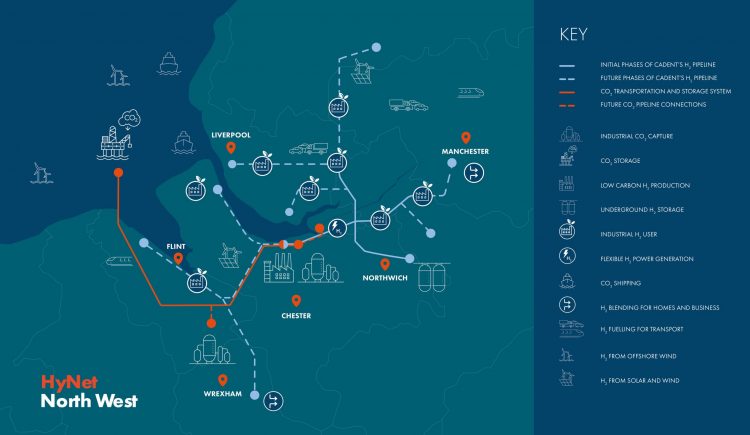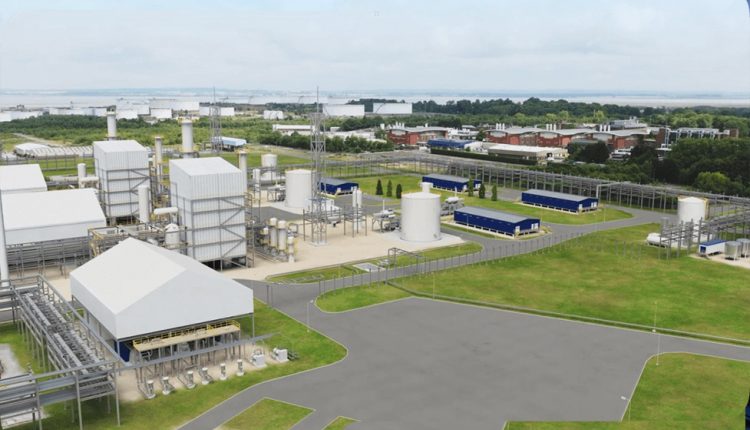Councillors approve £2bn hydrogen production and carbon capture plant close to River Mersey which it is claimed will save 2.5m tonnes of carbon each year. Tony McDonough reports

Planners at Cheshire West and Chester Council have approved a £2bn hydrogen production and carbon capture plant to be built close to the River Mersey.
LBN revealed in September that engineering and design work had started on the project, which is located at the Stanlow oil refinery at Ellesmere Port. It will eventually supply up to 1,000MW of hydrogen to industrial giants such as Pilkington and Tata Chemicals.
EET Hydrogen (formerly Vertex Hydrogen), a joint venture between Essar Oil UK, owner of the refinery, and low carbon energy firm Progressive Energy, is behind the project. It forms part of the wider HyNet hydrogen project.
Hydrogen will be produced at Stanlow by burning natural gas and piped to industrial customers across the North West. This method would usually produce significant carbon emissions, contributing to global warming and climate change.
However, HyNet’s plan is to invest in carbon capture and storage (CCS). Once captured the carbon will be piped to depleted gas fields under Liverpool Bay where it will be stored indefinitely.
CCS is a controversial technology. For the process to be viable it has to successfully capture and store between 90% and 95% of the carbon. This has never been achieved on the scale proposed by HyNet anywhere in the world.
According to the planning documents EET is looking to capture up to 97% of the CO2 produced by the hydrogen plant.
Comprising two plants (HPP1 and HPP2) located on a 71-acre site, the hydrogen hub will enable local industrial and power generation businesses to switch from fossil fuels to hydrogen.
EET claims this will help to reduce the North West’s carbon emissions by 2.5m tonnes every year – the equivalent of taking 1.1m cars off the roads.
Construction is anticipated to start on HPP1 in 2024 with low carbon hydrogen produced at the site by 2027.
Richard Holden, HPP1 project nanager at EET, said: “This is the largest low carbon hydrogen project in the UK and one of the most advanced in the world.
“It is a vital piece of the North West’s journey to net zero, underpinning HyNet and providing the opportunity for manufacturers in the region to decarbonise their processes and support UK jobs.”
HPP1 will create infrastructure to enable a hydrogen production capacity of up to 350MW. HPP2 will include an additional hydrogen process area and associated plant increasing the production capacity of the HPP three-fold, by a further 700MW.
EET has an ambition to deliver around 4GW of low carbon hydrogen by 2030, around 40% of the UK Government’s national target. It secured funding for the project from the Government in March.
Hydrogen produced in project phase 1 is proposed to be utilised locally by the refinery as well as by nearby industries.
This planning application was ‘hybrid’ in that it seeks both full and outline planning permission for different components of the development. Full planning permission was sought for the majority of the project phase one infrastructure.
Outline planning permission (with all matters reserved) was sought for the residual phase one infrastructure and all of the project phase two infrastructure.
There remain big question marks over the project and whether it will live up to its promise to make a real contribution to the UK’s net zero targets.

Hydrogen is the most abundant element in the universe and at the point of use it is emissions-free. But to obtain energy from hydrogen we first have to separate it from other elements in fossil fuels or water. There are a number of ways of doing this.
So-called grey hydrogen is hydrogen produced using fossil fuels, as above, but the resultant carbon is released into the atmosphere contributing to global warming and climate change.
At the other end of the scale is green hydrogen. This is produced by running electricity from renewable sources such as wind or solar through a machine called an electrolyser. It separates the hydrogen from water molecules.
READ MORE: Essar Oil UK returns to profit as revenues top £9bn
This is by far the best way to produce hydrogen in terms of cutting carbon emissions. However, green hydrogen is currently expensive and not yet at the point where it can be sufficiently scaled up.
HyNet has chosen to produce what is called blue hydrogen which employs CCS. It adds it is future-proofing the infrastructure to eventually pivot towards green hydrogen.
HyNet is investing in a number of smaller scale green hydrogen projects. It will utilise electricity from the Frodsham Wind Farm close to the Mersey Estuary.

